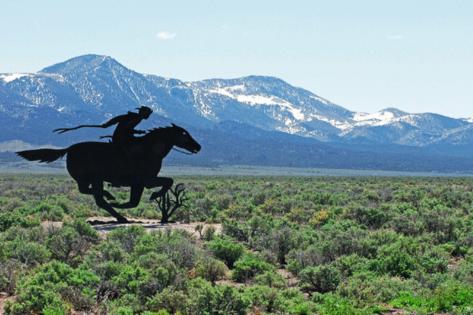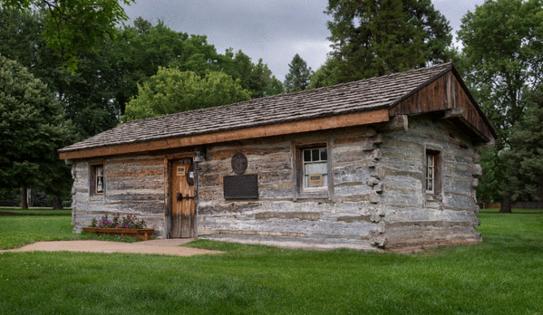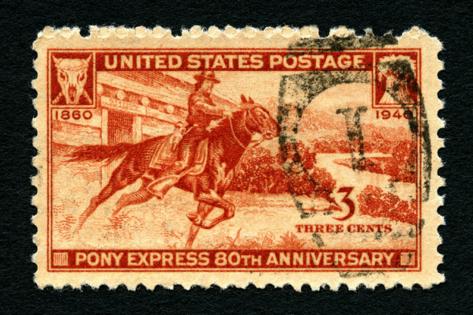Follow the Historic Trail of the Pony Express
Around 1857, a man named Gerat Hollenberg and his wife, Sophia, built a modest wood-shingled house in present-day Kansas, four years before the territory became a state. The structure also served as a grocery store, tavern and unofficial post office for immigrants following the Oregon-California Trails. Three years later it became one of the first stations along the Pony Express route.
That pathway stretched some 1,900 miles between St. Joseph, Missouri, and Sacramento, California, and was followed by horseback-riders delivering mail. The Hollenberg home still stands and is a rare example of a remaining Pony Express station that exists unaltered in its original location.
The Pony Express mail service ranks high on the list of American West lore. It combines romance with robust horses and riders, stamina with bravery, and recalls a time when something we take for granted today -- delivering mail -- called on men and beasts to stretch their endurance to the limit.
As the United States expanded westward, the postal service faced the challenge of doing the same. In 1860, a network of close to 190 "stations" was established along the route. These modest buildings were located 10 to 15 miles apart, the distance that most horses could travel at top speed.
At each station, Pony Express riders could get a quick bite to eat and would change to a fresh steed and transfer the pouch containing mail to their new mount. These lightweight leather packs, which were known by the Spanish word mochila (which means knapsack or pouch), were hung across the horse's saddle.
Today people seated in a car rather than astride a horse can retrace sections of the historic Pony Express route and see places that recall its colorful story.
While there is no record of any female Pony Express riders, woman did play a role during the life of the service. Their primary task was to feed not only the riders but also station-keepers, blacksmiths and other men who together kept the mail moving.
One woman who lived near a station in the Nebraska Territory was reported to have transformed up to 100 pounds of flour a day into bread and muffins, make cheese and prepare other food for the Express men. The stop in Seneca, Kansas, which also served as a hotel, was popular -- according to a contemporary report -- "not only for its comfortable accommodations but also because Mrs. Smith was an excellent cook."
The former Hollenberg Station in Hanover, Kansas, today is operated as a historic site by the Kansas State Historical Society. It displays period furnishings and clothes along with interpretive exhibits about the Pony Express.
The Pony Express National Museum in St. Joseph, Missouri, displays a collection of "Travel the Trail" historic photographs and a Hall of Riders, which pays homage to the men who delivered the mail. One of them, named Theodore Rand, rode the Express during the entire period of its life. William Hamilton was the first Pony Express rider to begin the journey from Sacramento.
The most famous of all the riders was William "Buffalo Bill" Cody, a bison-hunter, soldier and showman who joined the Pony Express when he was 15 years old. He followed a hazardous route that included crossing an ice-cold, swiftly flowing stream three times within a space of 60 yards.
James "Wild Bill" Hickok, a soldier, scout, gunslinger and lawman, was another well-known Old West figure who was associated with the Pony Express. He didn't ride the horses but rather spent time tending to them. Advertisements seeking to attract riders didn't pull any punches: "Wanted: Young, skinny, wiry fellows not over 18. Must be expert riders, willing to risk death daily. Orphans preferred."
Because one of the originators of the Pony Express was a religious man, each rider was given a Bible and required to sign an oath that read, in part: "I will, under no circumstances, use profane language, drink no intoxicating liquors, will not quarrel or fight with any other employee of the firm."
Given its fame, some people are surprised to know how short the life span of the Pony Express was. Nineteen months after it was launched in 1860, it was replaced by the telecommunication line constructed by the Pacific Telegraph Co. Despite that brief existence, it earned a place as a lasting legend in the story of the country's growth.
----
WHEN YOU GO
For more information: nps.gov/poex
========
Victor Block is a freelance writer. To read features by other Creators Syndicate writers and cartoonists, visit the Creators Syndicate website at www.creators.com.
Copyright 2025 Creators Syndicate, Inc.



































Comments